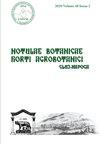应用小孢子根霉和米曲霉提高茄子幼苗对黑线蛾的防御能力
IF 1.3
4区 生物学
Q3 PLANT SCIENCES
引用次数: 1
摘要
几种植物病原体侵袭茄子,造成作物损害。根结线虫(Root-Knot Nematode, RKN)是最具破坏性的植物病害之一,对茄子幼苗造成严重危害。寻找安全有效的生物替代品来预防严重限制植物生产力的茄子根线虫病,是本研究的创新之处。本研究对6株植物生长促进真菌(PGPF)进行了研究,以提高茄子幼苗在未知旋律线虫(Meloidogyne incognita)侵染下的生化防御和生理生化性能。对PGPF分离株进行了体外生化特性测试,如铁载体和HCN产量。此外,还对PGPF滤液进行了体外拮抗实验。产HCN的最佳菌株分别为F5和F3。96 h后,F5和F3的线虫幼虫死亡率最高,分别为74.20%和60.35%。此外,F5的抗氧化活性最高,IC50为145µg/mL,其次是F3, IC50为350µg/mL。因此,F5和F3完全鉴定为小孢子根霉(OQ291571.1)和米曲霉(OQ291572.1)。将小孢子丝虫和米芽孢霉共同进行体内研究是最成功的治疗方法,在患病幼苗中,雌虫、虫瘿、发育阶段、卵块、二幼虫的线虫记录分别减少95.23%、86.98%、80.35%、80%和68.78%。综上所述,利用米芽孢霉和小孢子霉的乙酸乙酯提取物(EAE)可作为茄子的刺激剂和抗线虫剂,用于茄子对隐芽孢霉的拮抗。本文章由计算机程序翻译,如有差异,请以英文原文为准。
Application of Rhizopus microsporus and Aspergillus oryzae to enhance the defense capacity of eggplant seedlings against Meloidogyne incognita
Several phytopathogens attack eggplant, causing crop damage. One of the most destructive plant diseases, Root-Knot Nematode (RKN), causes significant damage to eggplant seedlings. Finding safe and effective biological alternatives to prevent eggplant root nematode disease, which significantly limits plant productivity, is the innovative aspect of this study. Six isolates of plant growth-promoting fungus (PGPF) were tested in the current work for improving biochemical defense and physio-biochemical performance in eggplant seedlings under the Meloidogyne incognita challenge. PGPF isolates were tested in vitro for some biochemical traits such as Siderophores and HCN production. Besides, the antagonistic efficacy of PGPF filtrates against M. incognita was tested in vitro. The best isolates capable of producing HCN were F5 and F3 respectively. Also, F5 followed by F3 exhibited the maximum mortality proportions of 74.20% and 60.35% mortality in nematode juveniles after 96 hours respectively. Moreover, F5 has the highest level of antioxidant activity, with IC50 145 µg/mL followed by F3 with IC50 350 µg/mL. thus, we identified F5 and F3 completely as Rhizopus microsporus (OQ291571.1 and Aspergillus oryzae OQ291572.1. Implementing R. microsporus and A. oryzae collectively in vivo study was the most successful therapy, limiting nematode recordings as 95.23%, 86.98%, 80.35%, 80%, and 68.78% reduction in females, galls, developmental stage, egg masses, second juveniles, respectively, in diseased seedlings. It could be suggested that the use of ethyl acetate extracts (EAE) of A. oryzae and R. microsporus might be commercially applied as a stimulator of eggplant and or anti-nematodes against M. incognita.
求助全文
通过发布文献求助,成功后即可免费获取论文全文。
去求助
来源期刊

Notulae Botanicae Horti Agrobotanici Cluj-napoca
PLANT SCIENCES-
CiteScore
2.70
自引率
0.00%
发文量
118
审稿时长
3 months
期刊介绍:
Notulae Botanicae Horti Agrobotanici Cluj-Napoca is a peer-reviewed biannual journal aimed at disseminating significant research and original papers, critical reviews and short reviews. The subjects refer on plant biodiversity, genetics and plant breeding, development of new methodologies that can be of interest to a wide audience of plant scientists in all areas of plant biology, agriculture, horticulture and forestry. The journal encourages authors to frame their research questions and discuss their results in terms of the major questions of plant sciences, thereby maximizing the impact and value of their research, and thus in favor of spreading their studies outcome. The papers must be of potential interest to a significant number of scientists and, if specific to a local situation, must be relevant to a wide body of knowledge in life sciences. Articles should make a significant contribution to the advancement of knowledge or toward a better understanding of existing biological and agricultural concepts. An international Editorial Board advises the journal. The total content of the journal may be used for educational, non-profit purposes without regard to copyright. The distribution of the material is encouraged with the condition that the authors and the source (Notulae Botanicae Horti Agrobotanici Cluj-Napoca or JCR abbrev. title Not Bot Horti Agrobo) are mentioned.
 求助内容:
求助内容: 应助结果提醒方式:
应助结果提醒方式:


